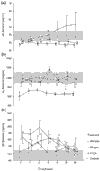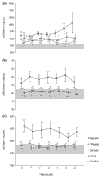Adhesion molecules in different treatments of acute myocardial infarction
- PMID: 11353931
- PMCID: PMC31578
- DOI: 10.1186/cc1014
Adhesion molecules in different treatments of acute myocardial infarction
Abstract
Background: Tissue damage after ischemia and reperfusion involves leukocyte endothelial interactions mediated by cell adhesion molecules. This study was designed to determine the time course of soluble adhesion molecules in patients with acute myocardial infarction after attempted reperfusion by thrombolysis with tissue plasminogen activator (tPA) or streptokinase (SK), or percutaneous transluminal coronary angioplasty (PTCA).
Methods: In 3 x 10 randomly selected patients with acute myocardial infarction undergoing thrombolysis with tPA or SK, or treated with PTCA, plasma concentrations of soluble L-selectin, P-selectin, E-selectin, intercellular adhesion molecule-1 (ICAM-1), vascular cell adhesion molecule-1 (VCAM-1) and platelet endothelial cell adhesion molecule-1 (PECAM-1) were measured by enzyme-linked immunosorbent assay, 30 min and 1, 2, 4, 8, 12 and 24 hours after intervention.
Results: After thrombolysis with tPA, soluble L-selectin concentrations were persistently depressed and soluble PECAM-1 concentrations were elevated, compared with controls, SK and PTCA. While soluble VCAM-1 concentrations did not differ within the first hours after interventions between the three groups, soluble VCAM-1 rose by 24 hours after tPA thrombolysis but did not increase after SK and PTCA treatment. Soluble ICAM-1 concentrations were consistently elevated after PTCA compared with controls and thrombolysed patients. Soluble E-selectin was depressed after tPA thrombolysis and PTCA in comparison with controls, while the SK group showed an increase throughout the observation period. Soluble P-selectin was increased after PTCA and SK lysis up to 8 hours after treatment compared with controls, but no significant differences could be found between treatment groups.
Conclusion: Adhesion molecules mediating leukocyte endothelial interactions are altered subsequent to postischemic reperfusion and by treatment with thrombolytic agents and angioplasty. The clinical relevance of these biological changes remains to be determined.
Figures


Similar articles
-
Soluble cell adhesion molecules in patients with acute coronary syndrome.Chin Med J (Engl). 2000 Mar;113(3):286-8. Chin Med J (Engl). 2000. PMID: 11775266
-
Alterations in Circulating Adhesion Molecules in Acute Myocardial Infarction before and after Thrombolysis with Streptokinase.J Cardiovasc Thorac Res. 2013;5(4):139-41. doi: 10.5681/jcvtr.2013.030. Epub 2013 Dec 5. J Cardiovasc Thorac Res. 2013. PMID: 24404343 Free PMC article.
-
The effects of dipyridamole stress test on plasma levels of soluble adhesion molecules intracellular adhesion molecule-1, vascular cell adhesion molecule-1, E-selectin and L-selectin in patients with ischemic heart disease and patients with syndrome X.Coron Artery Dis. 1999 Jun;10(4):235-40. doi: 10.1097/00019501-199906000-00005. Coron Artery Dis. 1999. PMID: 10376202
-
Thrombolysis and percutaneous transluminal coronary angioplasty in patients with acute myocardial infarction.Z Kardiol. 2000;89 Suppl 4:IV30-40. doi: 10.1007/s003920070061. Z Kardiol. 2000. PMID: 10810775 Review.
-
The pathophysiological role of circulating adhesion molecules in schizophrenia: A systematic review and meta-analysis.Schizophr Res. 2024 Feb;264:157-169. doi: 10.1016/j.schres.2023.12.025. Epub 2023 Dec 26. Schizophr Res. 2024. PMID: 38150848
Cited by
-
Exploring the Landscape of Anti-Inflammatory Trials: A Comprehensive Review of Strategies for Targeting Inflammation in Acute Myocardial Infraction.Biomedicines. 2024 Mar 21;12(3):701. doi: 10.3390/biomedicines12030701. Biomedicines. 2024. PMID: 38540314 Free PMC article. Review.
-
Coronary No-Reflow after Primary Percutaneous Coronary Intervention-Current Knowledge on Pathophysiology, Diagnosis, Clinical Impact and Therapy.J Clin Med. 2023 Aug 27;12(17):5592. doi: 10.3390/jcm12175592. J Clin Med. 2023. PMID: 37685660 Free PMC article. Review.
-
Time course of VCAM-1 expression in reperfused myocardial infarction in swine and its relation to retention of intracoronary administered bone marrow-derived mononuclear cells.PLoS One. 2017 Jun 19;12(6):e0178779. doi: 10.1371/journal.pone.0178779. eCollection 2017. PLoS One. 2017. PMID: 28628621 Free PMC article.
-
Cortical bone stem cell-derived exosomes' therapeutic effect on myocardial ischemia-reperfusion and cardiac remodeling.Am J Physiol Heart Circ Physiol. 2021 Dec 1;321(6):H1014-H1029. doi: 10.1152/ajpheart.00197.2021. Epub 2021 Oct 8. Am J Physiol Heart Circ Physiol. 2021. PMID: 34623184 Free PMC article.
-
Kinetics and prognostic value of soluble VCAM-1 in ST-segment elevation myocardial infarction patients.Immun Inflamm Dis. 2021 Jun;9(2):493-501. doi: 10.1002/iid3.409. Epub 2021 Feb 8. Immun Inflamm Dis. 2021. PMID: 33559404 Free PMC article.
References
-
- ISIS-3 (Third International Study of Infarct Survival) Collaborative Group ISIS-3: a randomised comparison of streptokinase vs tissue plasminogen activator vs anistreplase and of aspirin plus heparin vs aspirin alone among 41,299 cases of suspected acute myocardial infarction. Lancet. 1992;339:753–770. - PubMed
-
- The GUSTO investigators An international randomized trial comparing four thrombolytic strategies for acute myocardial infarction. N Engl J Med. 1993;329:673–682. - PubMed
-
- Grines CL, Browne KF, Marco J, Rothbaum D, Stone GW, O'Keefe J, Overlie P, Donohue B, Chelliah N, Timmis GC. A comparison of immediate angioplasty with thrombolytic therapy for acute myocardial infarction. The Primary Angioplasty in Myocardial Infarction Study Group. N Engl J Med. 1993;328:673–679. - PubMed
-
- Kloner RA. Does reperfusion injury exist in humans? J Am Coll Cardiol. 1993;21:537–545. - PubMed
-
- Farb A, Kolodgie FD, Jenkins M, Virmani R. Myocardial infarct extension during reperfusion after coronary artery occlusion: pathologic evidence. J Am Coll Cardiol. 1993;21:1245–1253. - PubMed
Publication types
MeSH terms
Substances
LinkOut - more resources
Full Text Sources
Medical
Miscellaneous

